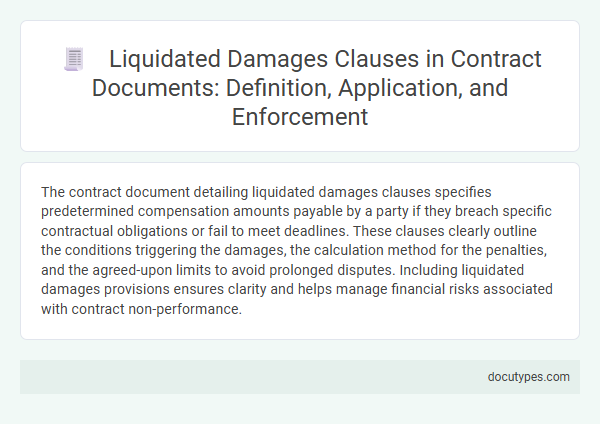The contract document detailing liquidated damages clauses specifies predetermined compensation amounts payable by a party if they breach specific contractual obligations or fail to meet deadlines. These clauses clearly outline the conditions triggering the damages, the calculation method for the penalties, and the agreed-upon limits to avoid prolonged disputes. Including liquidated damages provisions ensures clarity and helps manage financial risks associated with contract non-performance.
Introduction to Liquidated Damages Clauses
| Topic | Introduction to Liquidated Damages Clauses in Contract Documents |
|---|---|
| Definition | Liquidated damages clauses specify a predetermined amount of compensation payable if one party breaches specific terms, typically related to delays or non-performance. |
| Purpose | To establish a clear, enforceable financial penalty that reflects estimated damages without requiring proof of actual loss. |
| Common Contract Documents Containing Clauses | Construction agreements, supply contracts, service contracts, and purchase orders frequently include liquidated damages provisions. |
| Key Elements |
|
| Legal Considerations | Courts enforce liquidated damages clauses if the amount is a reasonable estimate of actual damages and not a penalty. |
Definition of Liquidated Damages in Contracts
Liquidated damages clauses specify predetermined compensation for breach of contract, ensuring clarity and fairness in potential disputes. These clauses define the exact amount payable when contractual obligations are not met within agreed terms.
- Definition Clarity - Liquidated damages are pre-agreed sums representing estimated losses from contract breaches.
- Purpose in Contracts - Such clauses aim to prevent lengthy litigation by providing fixed financial remedies.
- Document Inclusion - Liquidated damages details are typically found in the main body or special conditions of contract documents.
Legal Basis for Liquidated Damages Clauses
Contract documents outline the specific terms and conditions under which liquidated damages clauses are applicable. These clauses establish predetermined compensation for breaches, aiming to avoid lengthy litigation by specifying damages in advance.
The legal basis for liquidated damages clauses is rooted in contract law principles that enforce fairness and reasonableness. Courts typically require that these clauses represent a genuine pre-estimate of loss rather than a penalty, ensuring they are valid and enforceable.
Drafting Effective Liquidated Damages Provisions
Contract documents typically include liquidated damages clauses within the general conditions or special provisions sections, clearly outlining the predetermined compensation for breaches such as project delays. Drafting effective liquidated damages provisions requires precise quantification of potential losses, ensuring the amounts are reasonable and enforceable under applicable law. Clear language and specificity in performance benchmarks help prevent disputes and facilitate smoother contract administration.
Common Applications in Contract Documents
Contract documents detailing liquidated damages clauses commonly include construction contracts, service agreements, and purchase orders. These clauses specify predetermined compensation amounts if contractual obligations are not met within the agreed timeframe or standards. Understanding your contract's liquidated damages provisions helps manage risk and ensures clarity on potential financial penalties.
Distinction Between Liquidated Damages and Penalties
The contract document detailing liquidated damages clauses typically includes a clear specification of the predetermined amount payable in case of breach or delay. This section outlines the basis for calculation, the events triggering the damages, and the agreed timeframe for payment.
Liquidated damages are distinct from penalties in that they represent a genuine pre-estimate of loss rather than a punishment for breach. Courts generally enforce liquidated damages clauses if the amount is reasonable and reflects anticipated damages, whereas penalty clauses are often deemed unenforceable.
Judicial Interpretation and Enforcement
Contract documents detailing liquidated damages clauses play a crucial role in judicial interpretation and enforcement. Courts examine these clauses to determine their reasonableness and applicability based on the contract terms and circumstances.
- Clarity and Specificity - Liquidated damages clauses must be clearly defined to ensure enforceability and avoid being ruled as penalties.
- Judicial Interpretation - Courts interpret these clauses by assessing if the stipulated damages are a genuine pre-estimate of loss at the time of contract formation.
- Enforcement Criteria - Enforceability depends on whether the clause protects legitimate interests without imposing punitive damages on You.
Effective contract drafting minimizes disputes by aligning liquidated damages clauses with judicial standards and enforcement principles.
Limitations and Legal Challenges
What contract document details liquidated damages clauses and their limitations? The contract's section on liquidated damages specifies the predetermined amount payable for breaches, setting clear financial expectations. Legal challenges often arise when these clauses are deemed penalties rather than genuine pre-estimates of loss, affecting enforceability.
Practical Considerations for Contract Parties
Liquidated damages clauses are typically detailed within the main contract agreement, specifying the pre-agreed compensation for breach or delay. Contract parties must carefully evaluate these clauses to ensure clarity, enforceability, and alignment with project risks and timelines.
- Contract Agreement Section - This section explicitly outlines the amount and conditions triggering liquidated damages, providing a clear basis for enforcement.
- Clarity and Precision - Precise language is essential to avoid disputes over the calculation or applicability of liquidated damages.
- Risk Allocation - Parties should consider the risk and potential financial impact when negotiating liquidated damages to balance fairness and motivation for timely performance.
What Contract Document Details Liquidated Damages Clauses? Infographic

